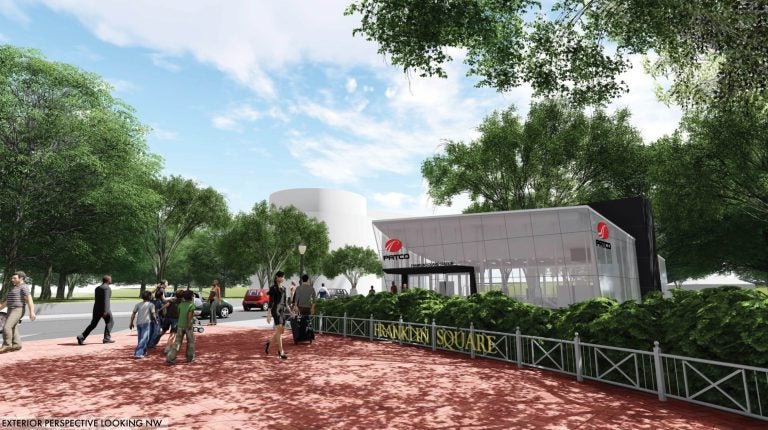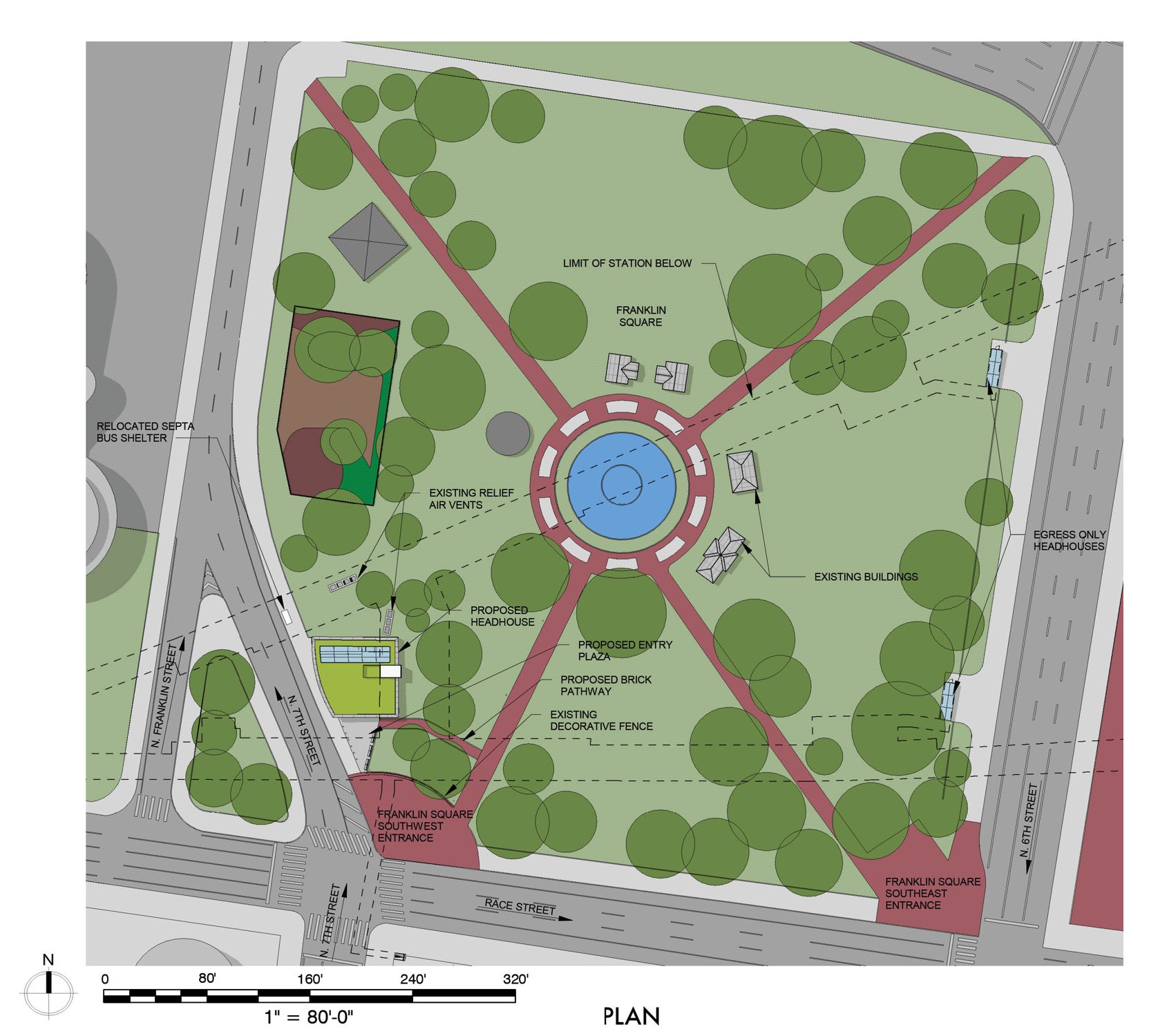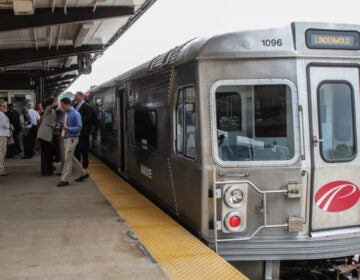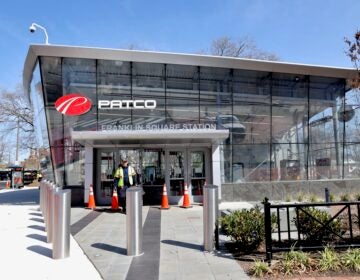PATCO overlooked Chinatown in plans to reopen Franklin Square Station
A Chinatown resident opposes PATCO’s plan to reopen Franklin Square Station because of threats to green space and other possible impacts.

(Courtesy of PATCO)
The U.S. Department of Transportation, last week, awarded PATCO a $12.6 million federal grant to help the Delaware River Port Authority transit corporation reopen Franklin Square Station. Labor leader John Dougherty, Delaware River Port Authority and PATCO deserve recognition for their persistence in making this decade-old dream come to true. For them, this station helps solve a perplexing problem: that Franklin Square, one of the historic squares of Philadelphia, has been “strangled by 676 to the north, a six-lane Race Street to the south, and the Ben Franklin Bridge to the east.”
What they don’t recognize is the problems that come when decision-makers treat transportation projects as if they exist in a vacuum. Unless they consider history, culture and community when they make decisions, these leaders unknowingly perpetuate continued erasure, inequity and systemic violence for communities nearby like Chinatown and Franklin Square, a recognized partner in Chinatown’s neighborhood plan.
One such example is the Vine Street Expressway.
As detailed in “Staying Put: Stories of Chinatown’s Resistance,” Cecilia Moy Yep was a 31-year-old widow with three children when she received a letter from the government, informing her that she would be evicted from her home in Chinatown due to a major urban renewal project. Authorities would later reveal the plan for Vine Street Expressway, one that would displace residents and destroy Chinatown’s beloved Holy Redeemer Church and school.
The Vine Street Expressway was championed by state, the Federal Highway Administration, PennDOT and Center City businesses. When authorities ignored Chinatown, Moy Yep and other residents began to organize, resisting “cultural genocide.” Chinatown youth had to block bulldozers with their bodies to get authorities to listen to them. In the end, Chinatown saved its church and school from demolition through a compromise proposal.
In the decades following, however, Chinatown and Franklin Square continuously suffered adverse impact from the expressway: it restricted Chinatown’s growth, caused a decline in quality of life, and impeded pedestrian access to Franklin Square, exacerbating the park’s decline. Moreover, scientists recently cited the expressway as the reason for a higher concentration of auto-related pollutants that contribute to respiratory illnesses for residents in Chinatown, Old City and Northern Liberties.
Is all development equitable development? Center City’s revival has come at the expense of Chinatown residents, who lost their homes because of developments like the Pennsylvania Convention Center. While IBEW98 Local leader John Dougherty rightly advocates for the Delaware River Port Authority to ensure equitable hiring, DRPA has been vague in articulating direct benefits to Franklin Square and Chinatown. If inclusive growth is a city and regional priority, there must be an inclusive pathway for impacted residents to receive job training, apprenticeships, jobs and procurement opportunities as it relates to this project.
Last week, PATCO CEO John Hanson announced that “there would be 1,500 new riders as result of that station.” Yet, past feasibility studies, costing $500,000 each, have recommended against reopening the station, concluding that “ridership would be too low to justify reopening the station.” With $30 million at stake, taxpayers should question why limited resources are being spent on re-opening this station, one that was already revived twice unsuccessfully.

There is also the question of why the project ballooned in cost from $10 million to $30 million. How could DRPA seek input on the new design from board members for 10 years without committing the same resources and time to engage residents, community-serving organizations and park users outside of one-time presentations? All environmental and feasibility studies should be made public.
DRPA and PATCO should be sensitive to the issues raised around equity, transparency and inclusion. Transportation projects have usually disproportionately displaced marginalized communities: that is the reason why President Bill Clinton signed Executive Order 12898, resulting in the U.S. Department of Transportation’s environmental justice strategy.
As history shows us, without attention to environmental justice, Chinatown and Franklin Square tend to get forgotten. The steady sacrifice of green space for the sake of development means that, at almost 190 years old, Chinatown only has one green space, Franklin Square (and one parklet). That space should be protected at all costs, especially in light of the toxic pollution brought to the community by the Vine Street Expressway.
Already, Franklin Square lost half its trees due to the construction of the PATCO station. With the coming renovation and reopening, even more green will be lost. The rationale for depleting more green space to build a larger headhouse is “it’s all about the passenger experience.”
But it’s time to center those most impacted by the Franklin Square PATCO project. To support inclusive growth and placemaking, planning efforts must be transparent, and involve and include Chinatown residents in culturally and linguistically appropriate ways. DRPA and PATCO have spent 10 years listening to certain stakeholders over others. They can make things right by being transparent and responsive to residents and community organizations now.
WHYY is your source for fact-based, in-depth journalism and information. As a nonprofit organization, we rely on financial support from readers like you. Please give today.






